I recently visited Lisbon in December. I was looking for a European city break with decent weather for that time of year. I was blown away by the Portuguese capital, and I totally understand why it is so popular. While I was there though, most of the voices I heard on the streets were not Portuguese, yet I was in visiting Lisbon in winter.
I got the distinct impression that peak tourist season here must be brutal, with the triumvirate of heat, hills, and crowds. But Lisbon in winter is significantly quieter, so you’ll avoid all that, while also saving money on hotels, restaurants, things to do, and day trips.
Put simply, with fewer tourists around you’ll enjoy the city’s culture, history, and cuisine more authentically, and visiting in the off-season may also help to minimize the social issues that Lisbon’s popularity among tourists and digital nomads has created.
So, in this guide I’ll be sharing the best things to do in winter, where to stay, and all the seasonal tips you need to experience Lisbon like a local. So sit back, grab a Pastel de Nata, and let’s get planning…
THE BENEFITS OF VISITING LISBON IN DECEMBER & WINTER
Lisbon is blessed with so many cool things to do, a rich history, great food, wonderful architecture, and a lovely natural setting, and they all combine to make it worth visiting in all seasons. Nonetheless, I visited Lisbon in December, and my accommodation was cheap, tours were still operating but with far less other tourists, getting around town on public transport was a pleasure, and I could walk into any restaurant without having to book a single one of them.
Meandering my way through old town Lisbon and popular spots including Alfama, was a pleasure, and I was able to appreciate the origins and spirit of these neighbourhoods to a far greater extent than if I was sharing those narrow streets with more like me. As a result, I have no doubt that the best time to visit Lisbon is in the winter months. Here’s why…
From June 19th – 29th Heymondo are offering a 15% discount for all TTT readers on their travel insurance plans! So if you’re planning ANY trip this year, now’s the time to get covered!
ACCOMMODATION IS CHEAPER AND EASIER TO FIND
Securing a room in one of the best hotels in Lisbon isn’t that easy due to high demand and low availability. Visiting in fall or winter or increases your chances significantly, AND it saves you money. Pretty much everywhere in Europe is cheaper in the off-season, but this is especially the case here, where competition for beds between April to October is huge.
When compared with other European cities, Lisbon is blessed with comparatively low-priced accommodation options at all price points, in all seasons. Notwithstanding, based on my research and experience, hotel prices in winter seem to be around 1/3 cheaper again, so that should be enough to entice the tighter more ‘budget conscious’ among us.
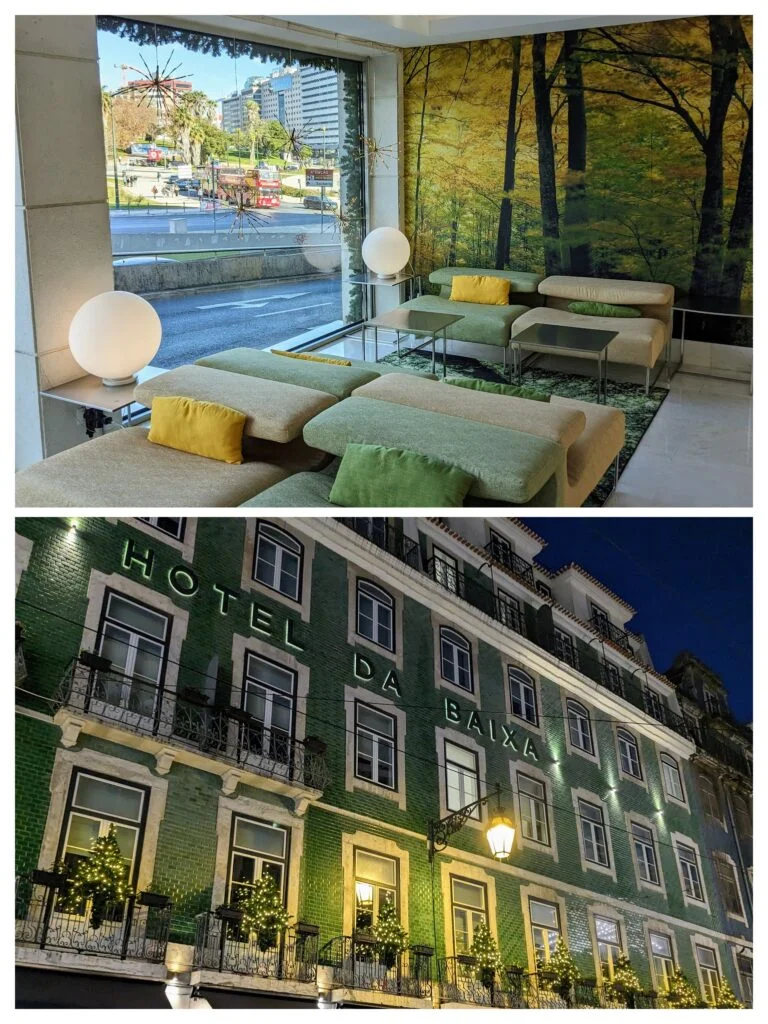
For a much deeper dive into which part of Lisbon to base yourselves in, check out my Alfama vs Chaido vs Baixa vs Bairro Alto vs Avenida battle royale post! In the meantime though, here are some great sustainable places to stay in Lisbon…
-
Hostels
-
Budget Hotels
-
Sustainable Hotels
-
Luxury Hotels
Check out either Lisbon Destination Hostel located inside the recently refurbished Rossio Railway station in the heart of Lisbon, Home Lisbon Hostel where you can enjoy home-cooked sociable meals from the owner’s mother herself, or Lisboa Central Hostel on Avenida Liberdades. Dorm and private rooms available.
I stayed in the HF Fenix Garden Hotel right on Marquis de Pombal Square at the top of Avenida de Liberdades. 3 nights in a double room overlooking Edward VII Park in December cost just €219 or (€73 per night). The room was excellent, with a gigantic bed and great views over the park.
A genuinely sustainable mid-range option to consider is the Inspira Liberdade Boutique Hotel, located on Avenida de Liberdades. This hotel is all about sustainability – they’ve invested in solar panels, use only eco-friendly and organic products, and they do regular city clean ups in partnership with Lisbon’s Botanical Garden. Respect.
Check out Dare Lisbon House located next to Chiado metro station, Hotel da Baixa in the heart of Baixa, or Corpo Santo Lisbon Historical Hotel about a 2 minute walk from Praça do Comércio (Commerce Square).
THINGS TO DO IN LISBON IN DECEMBER ARE LESS CROWDED
Lisbon Sunset Cruise
Taking a sunset boat tour in Lisbon on the second shortest day of the year was a bit of risk I admit, but with sunny weather and nobody else on-board, we effectively had a private tour! I was really impressed with the company for not cancelling due to their minimum number not having been met, so big respect to Palma Yachts.
Not only did we have the boat all to ourselves, but we had the company of two Portuguese crew, Luis and Tomas, and we were served sparkling wine and several glasses of Vinho Verde throughout the two-hour cruise around the Tagus estuary. All things considered, value for money wise, this was unbeatable.

Where does the Lisbon Sunset Cruise start?
The tour started at Belem docks, pretty much opposite the famous Fábrica de Pastéis de Belém & the Jerónimos Monastery (both can lay equal claim to being where the famous Pastel de Nata egg tarts originated). We were met by our skipper and crew right next to the Monument of the Discoveries or ‘Padrão dos Descobrimentos’. Because of all these big hitting attractions in Belém, gettingot the meetingpoint was easy due to the regular buses and trams arriving from downtown Lisbon, taking around 25 minutes each way.
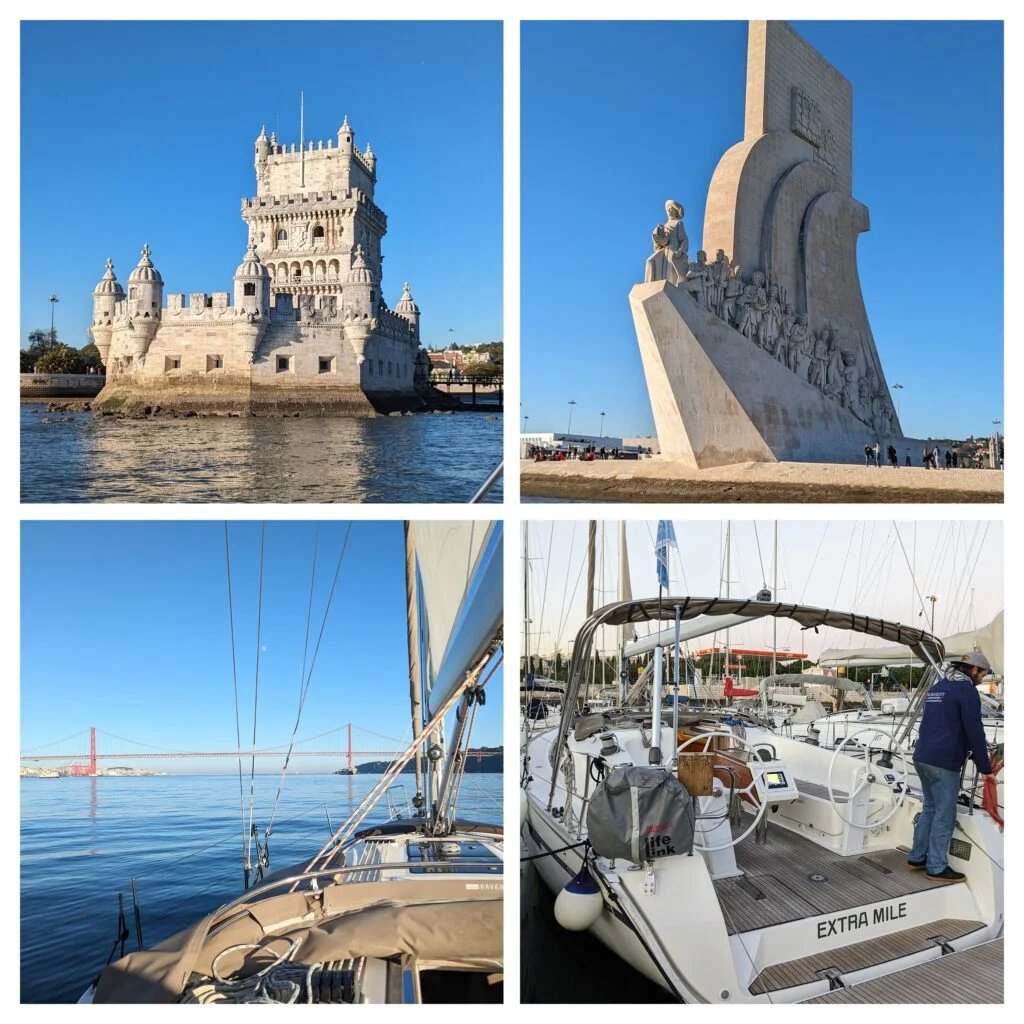
The Lisbon Sunset Cruise Itinerary
The outward journey took us upstream back towards Lisbon’s city center. En-route we enjoyed great views of the 25th of April Bridge and the Cristo Rei statue (Christ The Redeemer’s mini me). The boat crew were attentive throughout, giving us plenty of information when we wanted it, but also being sensitive to our wish to chill out up front and enjoy the views when we wanted some privacy. They’d periodically check on us and offer wine top ups as well as little nuggets of insight as we sailed past various sites and monuments.
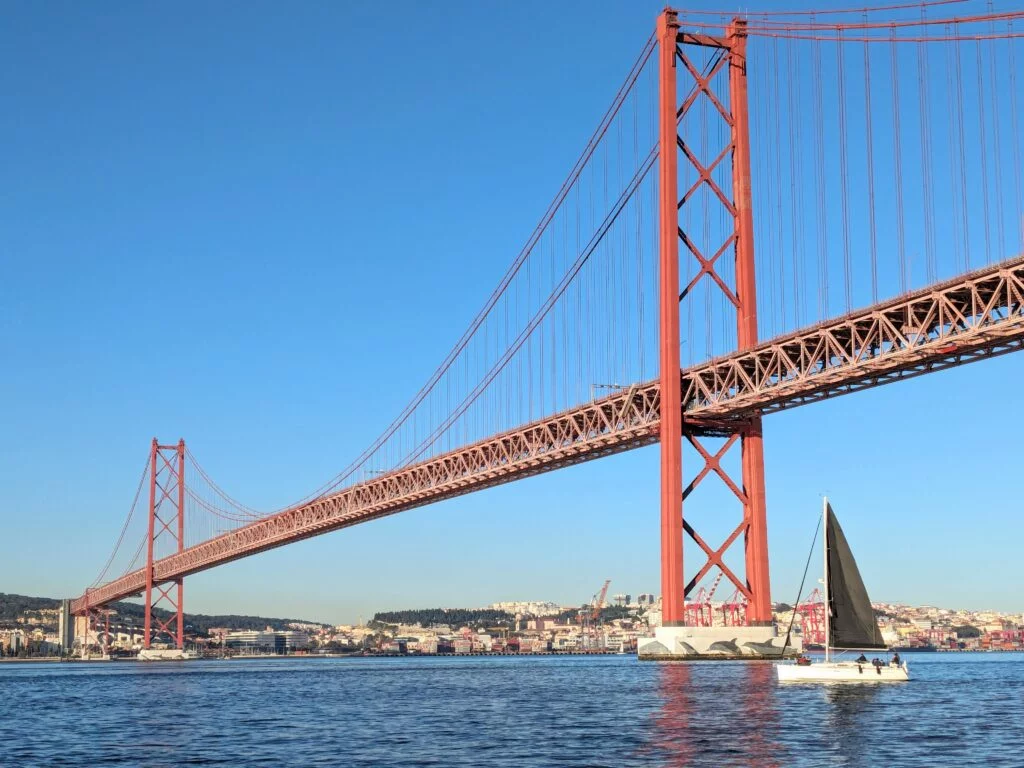
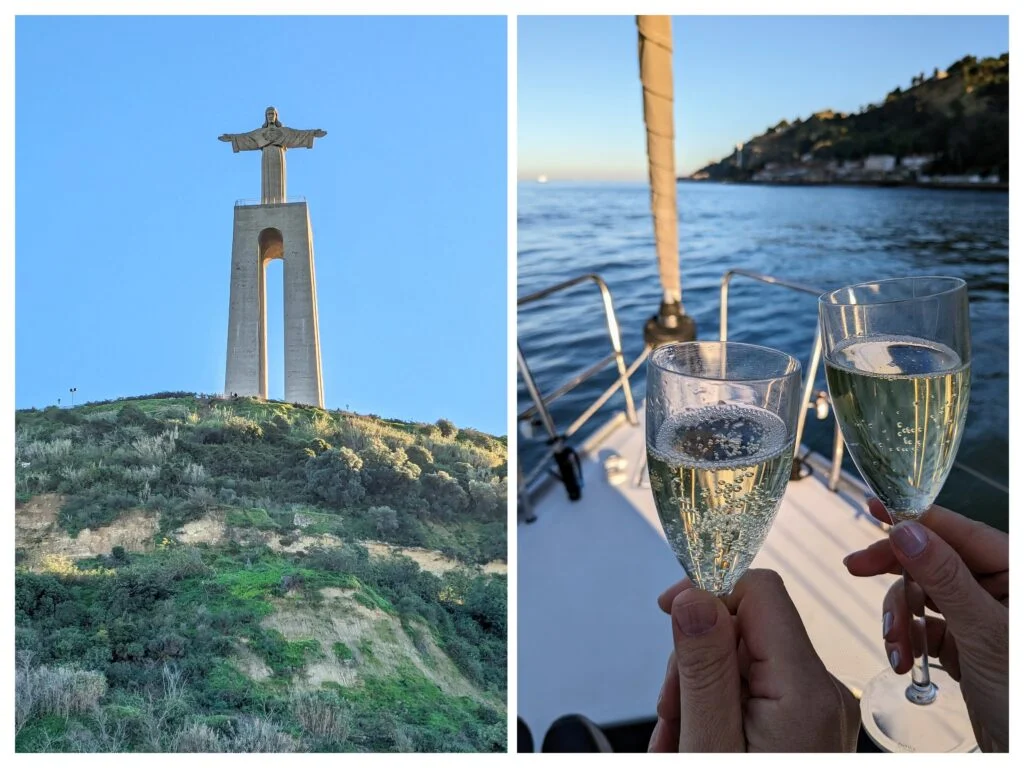
We turned around just after reaching Praça do Comércio (Commerce Square) and then headed back to our starting point in Belem with the low winter sun shining directly into our faces (bring sunglasses). At this time of year, the river was almost empty, and while it did get a bit chilly on-board, that was only because I decided not to bring a jumper, so sensible people would be just fine, I’m sure.
The views were great and the vibe was summery, but what really made the experience so special was feeling like we had the entire Tagus river to ourselves. There’s no way this kind of personal attention would be possible in summer. If you want to book it, then go ahead as the whole experience was such a great way to see the main maritime sites of Lisbon.
City Tours in Winter
For the slightly more active among you, the 3hr Lisbon 7 Hills Guided Electric Bike Tour is a great way to give your legs a bit of a break. Tours operate throughout winter apart from Christmas Eve, Christmas day and New Year’s day, at various times in the morning, afternoon and evening. With an electric bike, reaching places like Castelo de São Jorge and Alfama with its hilly winding network of streets is much easier. It’s a great way to get some brilliant views (and photo opportunities) over the city. It’s bookable with both Viator and Get Your Guide.
Alternatively, if walking is more your thing, then consider a private walking tour of Lisbon’s main sights. Tours depart at either 10am, 11am or in the afternoons at 3:30pm. These 3 hour long walking tours are incredibly good value – you’ll visit Alfama, Bairro Alto, miradouros (viewpoints), cathedrals, castles and Lisbon’s most important squares. It’s great to see a private tour that doesn’t cost the earth!
Food Tours in Winter
Thankfully, many food tour operators operate their tours in winter largely as they do in summer, and they’re always a great way to learn about the local culture. Last December I did this Food and Wine Walking Tour with Inside Lisbon. We sampled cod fritters, several wines, cheeses and cured meats, and we enjoyed a Bifana too.
I’d best describe it as a food grazing tour, with small tasters and drinks. We got some good historical info and context from our guide, but I was still a little hungry afterwards (although this may just be because I’m a greedy f@%ker).

Tastes and Traditions Food Tour
This year Papa TTT went to Lisbon on my behalf to take The Tastes and Traditions Tour from Devour Tours. This is a comprehensive exploration of some of Portugal’s most iconic dishes, both sweet: Pastel de Nata, Bola de Berlim, and Pao de Deus, and savoury: Bacalhau a Bras, Arroz de Marisco (seafood rice), Bifana (pork sandwich), as well as various other cured meats and drinks.
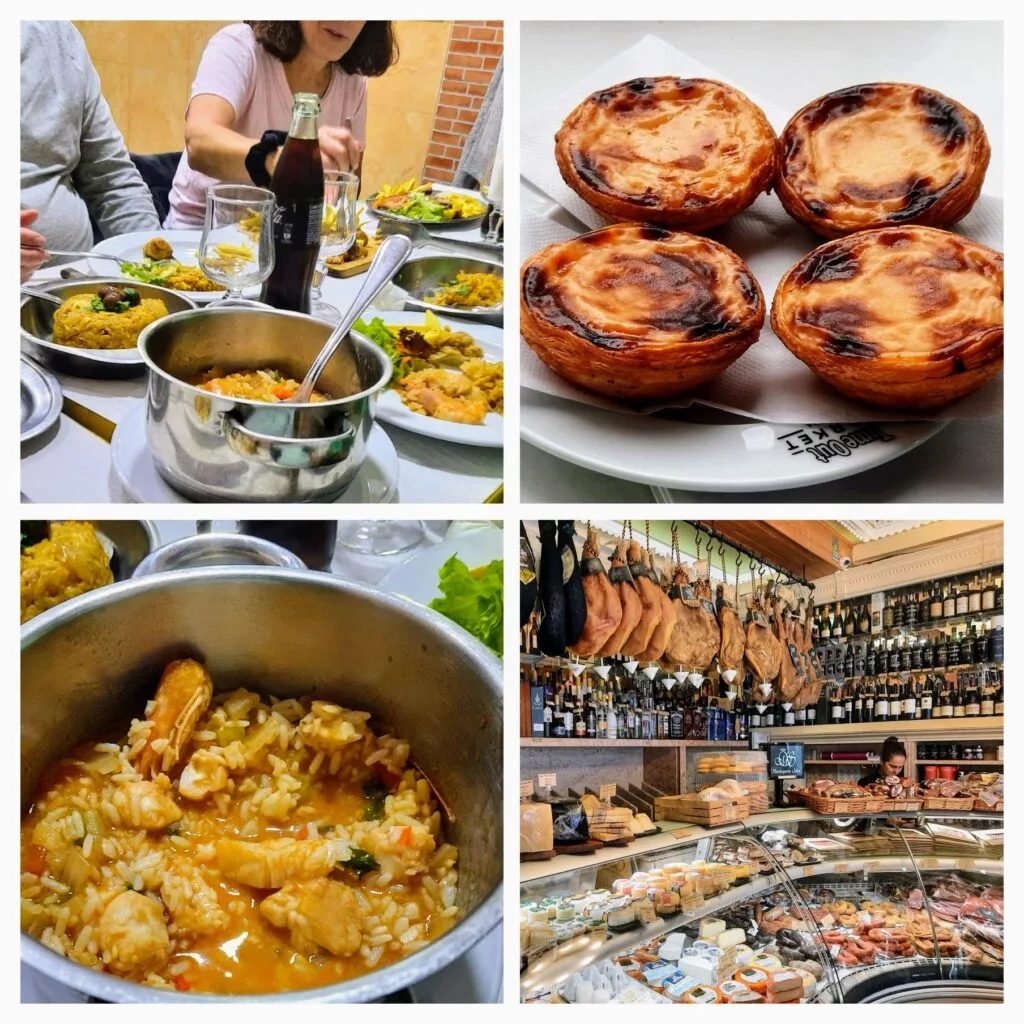
It’s amazing value for what you get, and the tour includes several iconic local culinary institutions on its itinerary. When booking directly, you’ll also get it much cheaper than if you use Get Your Guide or Viator. Tours run 6 days a week in December and throughout the rest of the year, apart from in January when they appear to have days off on Sundays, Wednesdays & Thursdays.
Alternatively, check out…
1) the Undiscovered Lisbon Food & Wine Tour, which focuses on the neighbourhoods of Baixa and Mouraria. Best for those interested in the influence of Portugal’s colonies on its modern-day food culture. This tour is offered every day through winter, apart from the 24th and 25th of December, and January 1st, at several different times from morning til night.
or…
2) if you fancy a night out through two of Lisbon’s most atmospheric neighbourhoods, then you can also do a Food and Fado Tour in Alfama and Mouraria. Downside is that this tour only operates twice a week in December on Tuesdays and Saturdays.
Cooking Classes in Lisbon
If you want to learn how to cook Portuguese food (and not just eat it), then you have options. Cooking Lisbon offer a 3.5 hour Portuguese cooking class which includes a 3-course dinner. Classes operate throughout winter on Tuesday, Thursday, Friday and Saturday evenings at 6:30pm. Local wine and nibbles are provided as you cook – so take it easy on the vino otherwise your final dish is gonna be bad!
Of course, no visit to Lisbon would be complete without indulging in its most famous export, the Pastel de Nata. Loved the world over, you can learn how to make this luscious golden jewel at one of the following cooking classes:
1) at Nat’elier bakery alongside an expert pastry chef; or 2) with Home Cooking Lisbon at their headquarters. Both options last 2 hours, both operate pretty much every day through the winter at various times, and both let you take your golden creations home with you. But only option 2 also provides Portuguese liqueur tastings to accompany the masterclass (Port wines, Ginginha etc.).

I’ve written an entire post about my experiences with Portuguese Food, with all my recommendations on what to eat while you’re in town. Check it out, if like me, you’re a fatty foodie.
DAY TRIPS FROM LISBON IN WINTER
Lisbon is surrounded by some very popular day trip destinations within a couple of hours, be it Fátima, one of the world’s most important Catholic pilgrimage sites; Sintra with its palaces, gardens and Moorish castle; medieval Óbidos, with its cobbled street, whitewashed houses and fortified walls, or the record-breaking giant waves of Nazaré on Portugal’s central coast.
Most of these places though are hundreds of years old, and were not designed to host the huge number of tourists that gather there in summer on day trips from Lisbon. Óbidos, for example, is a tiny, one street medieval hamlet, which, through no fault of its own, loses at least some of its charm, as you slow shuffle your way through other sweaty tourists in peak season.
Here then, are my recommendations for unique tours, from tour companies that have clearly thought about avoiding the crowds and improving the quality of guest experience:
Day Tour to Nazaré, Óbidos, and Fátima

If you want to explore Portugal’s central coast, I can thoroughly recommend a day tour to Nazaré, Óbidos, and Fátima. It gives you a nice overview of several different aspects of Portugal’s past and present, by bringing you first to Portugal’s most important Catholic site, Fátima, the world’s biggest and scariest big wave surfing spot at Nazaré, and the charming medieval hamlet of Óbidos.
I did a slightly different tour last year, one that also included a visit to Bathala, but I found four locations in one day to be a little rushed, and I would have preferred more time in Nazaré.
Nazaré, is especially is good to visit in winter, by the way, as that’s when surfers from across the world stay in the small fishing village for months on end, waiting for the biggest swells of the winter to roll in. If you’re very lucky, you might catch a world record wave!
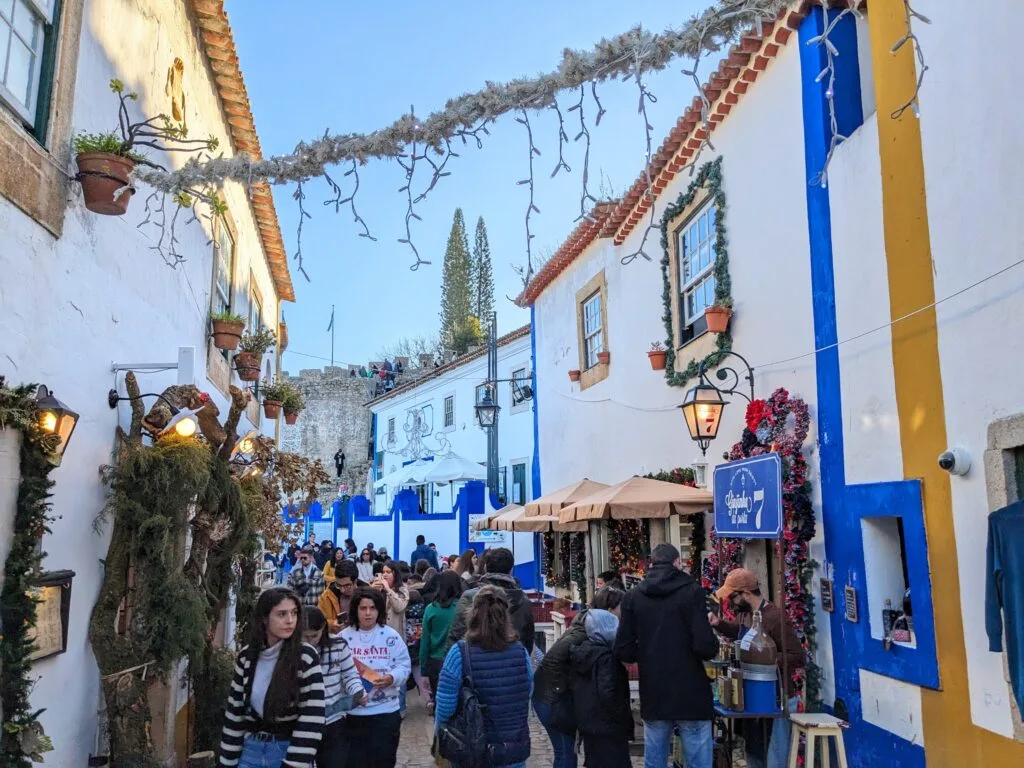
Sintra & Pena Palace
Walks have curated a half-day tour from Lisbon to Sintra, with two different starting times (07:30 or 14:30). While 07:30 may be a little too early for some, there’s a method behind the madness here, as the company have secured private access to the UNESCO world heritage Pena Palace, both before the main gates have opened (morning), and after they have closed to the public (afternoon). You’ll also visit Quinta da Regaleira, and Sintra town, and of course the tour includes round-trip transportation from Lisbon.
Lisbon Car Rental
You could of course hire a car in Lisbon and visit these places yourself. Driving means you can be there during the quieter times of the day, but of course, it also involves more planning and work from your side.
Anyway, if you do need car rental in Lisbon then do it with Discover Cars, they’re cheap, they cover all the local companies and the big national chains, so they have a huge selection of vehicles too. Do a search below and see what offers you get back.
ALFAMA AND OLD TOWN LISBON ARE WAY MORE RELAXED IN WINTER
Alfama, an integral part of old town Lisbon, is one of its most visited and historic neighbourhoods. Dating back to the Moorish period, it survived the earthquake of 1755, which destroyed much of the city. As a result, Alfama still retains its medieval layout and charm. It is a district with a strong sense of traditional Portuguese culture, known for its narrow streets, small squares, and traditional Portuguese houses with colourful tiled facades (azulejos). Many buildings have a Moorish influence, with whitewashed walls and red-tiled roofs, and the winding streets create a maze-like atmosphere.
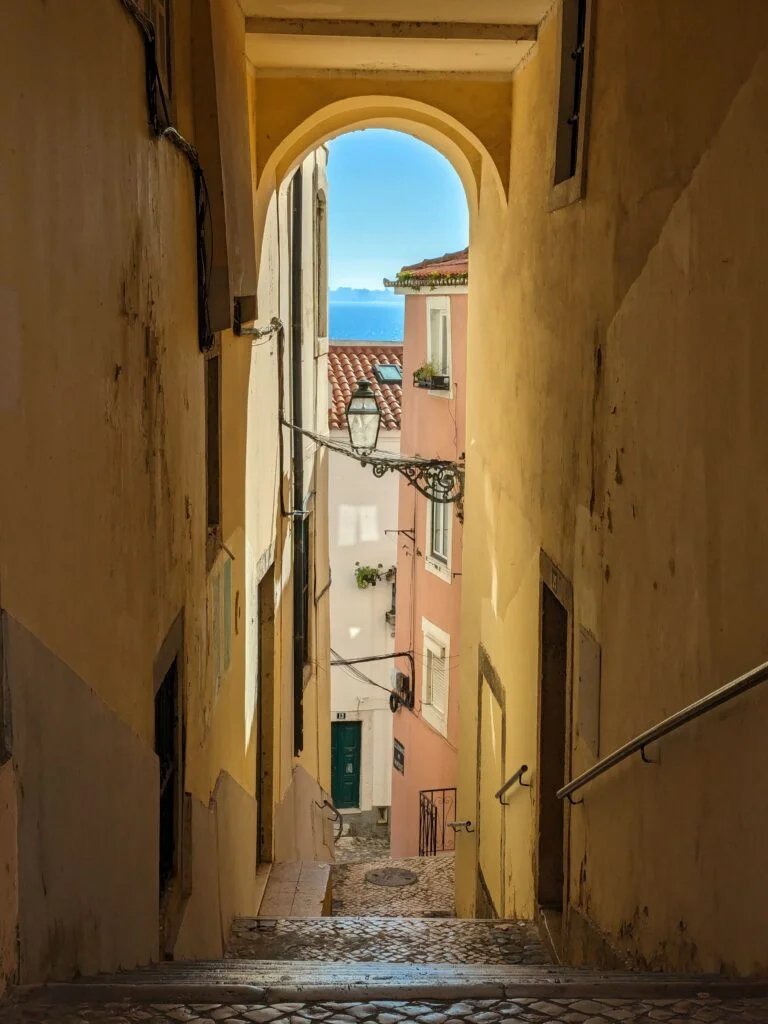
A once poor area, home to sailors and dockworkers, Alfama is also considered the birthplace of Fado, a genre of music characterized by its melancholic and soulful tunes. With open windows and hanging washing, its streets are often filled with traditional music, the smell of local cuisine, and the lively chatter of locals and tourists alike.
Old town Lisbon gets very busy in peak tourist season, so any romantic notion of getting lost in Alfama is likely to be spoiled by bicycle tuk tuks with booming music and six backpackers hanging out the back of it, so if I haven’t convinced you yet, visit Lisbon in Winter!
Aside from its inherent uniqueness, Alfama is popular because it is home to two of Lisbon’s most visited landmarks, i.e the São Jorge Castle, and the Se Cathedral – Lisbon’s oldest church. But, even these are significantly less crowded to visit during the winter months. However, if you are neither religiously or castley inclined (I use the word inclined deliberately here) these can be swerved to instead focus on local contemporary life in Alfama.
And for those of you wondering, I didn’t even have to sharpen my elbows to take this great photo (below) from one of the more popular Miradouros in Alfama. In winter you can access this, and other brilliant photo spots across the city, easily.
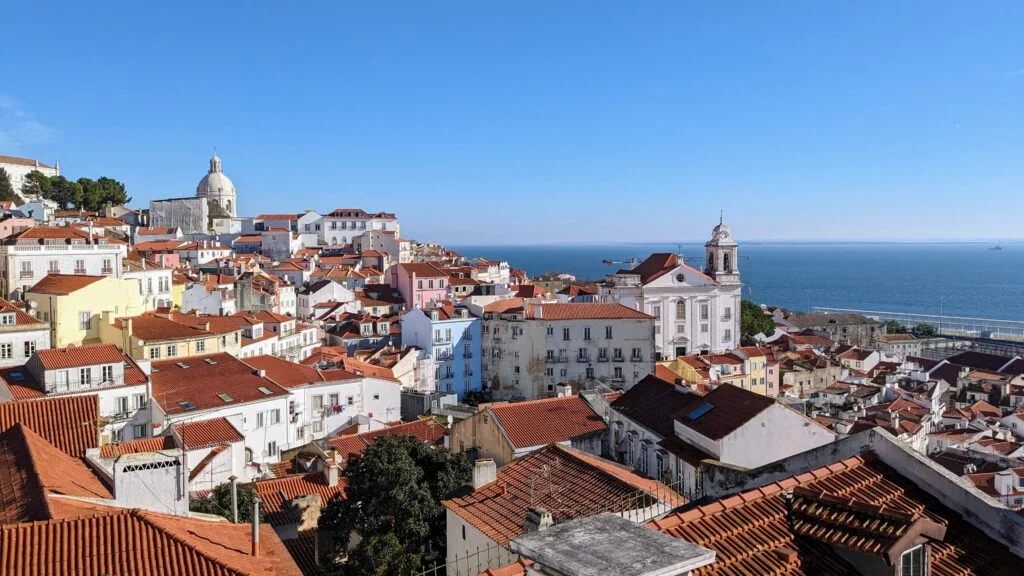
Lisbon Tram 28
In peak season tourists will queue for ages to ride the 28 tram, which zig-zags its way up to Alfama from the city center. If you’re not a fan of personal space, but you do enjoy standing up for long periods, as well as the diverse range of human body odours and breath on offer, then by all means go ahead – Lisbon’s tram 28 is waiting for you!
If on the other hand, you choose to visit Lisbon in Winter or Autumn, the 28 tram ride is in fact perfectly pleasant and relatively uncrowded, although also unremarkable in terms of views and overall experience. The 28 should be viewed as a means of getting people to and from Alfama (as was certainly intended by the Portuguese transport authorities), and not as an activity in and of itself.
Anyway, I recommend walking to Alfama from the centre (or taking the tram if your calves are already done), and then getting yourself well and truly lost. Choose any narrow street which looks to take you deeper into the abyss and find somewhere to sit, eat, people watch, or just wander around aimlessly for a few hours with eyes and ears open. With photogenic alleys and views everywhere you turn, you can’t help but imagine a life lived here in Lisbon’s old town.
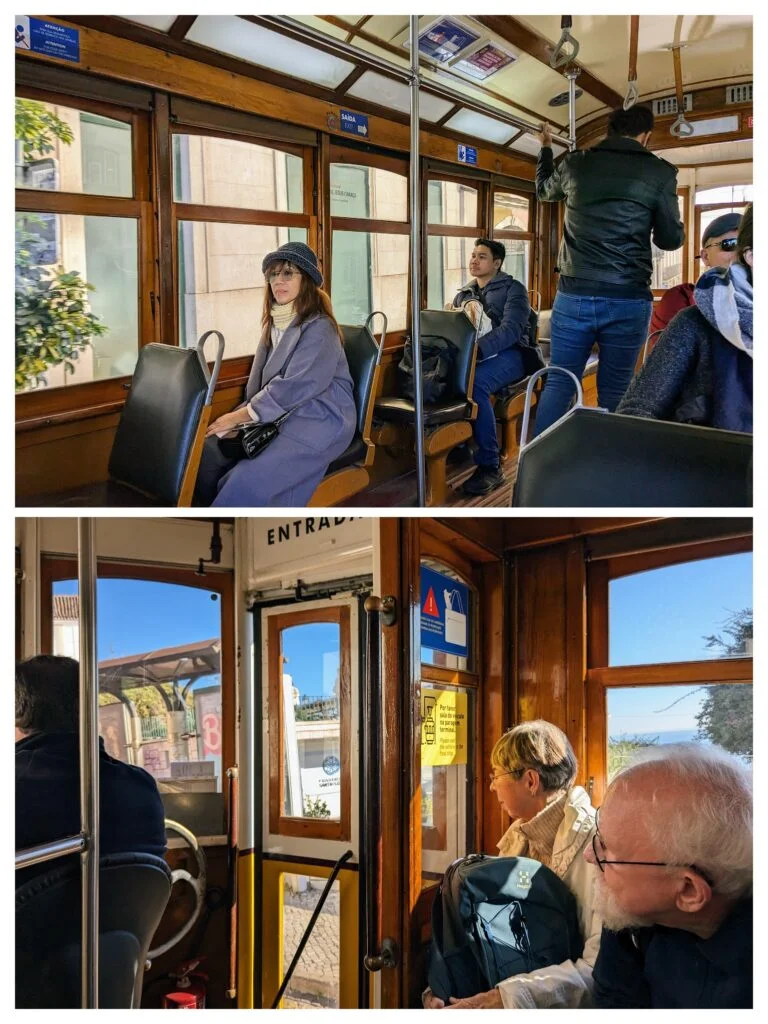
CHRISTMAS IN LISBON
Portugal clearly loves Christmas, and as a country it does it really well. This was evident by the many Christmas markets, decorations and lights lining the streets, buildings and national monuments. From strolling down Lisbon’s exclusive 1.5km Avenida de Liberdade with its gorgeous Christmas lights, to visiting the Christmas markets in Rossio and Edward VII Park, the general atmosphere in Lisbon in December was one of excitement and anticipation. This should be no surprise really, considering that Portugal is a deeply religious country with a rich modern history rooted in Christian folklore, and an estimated 85% of its population identifying as Roman Catholic.
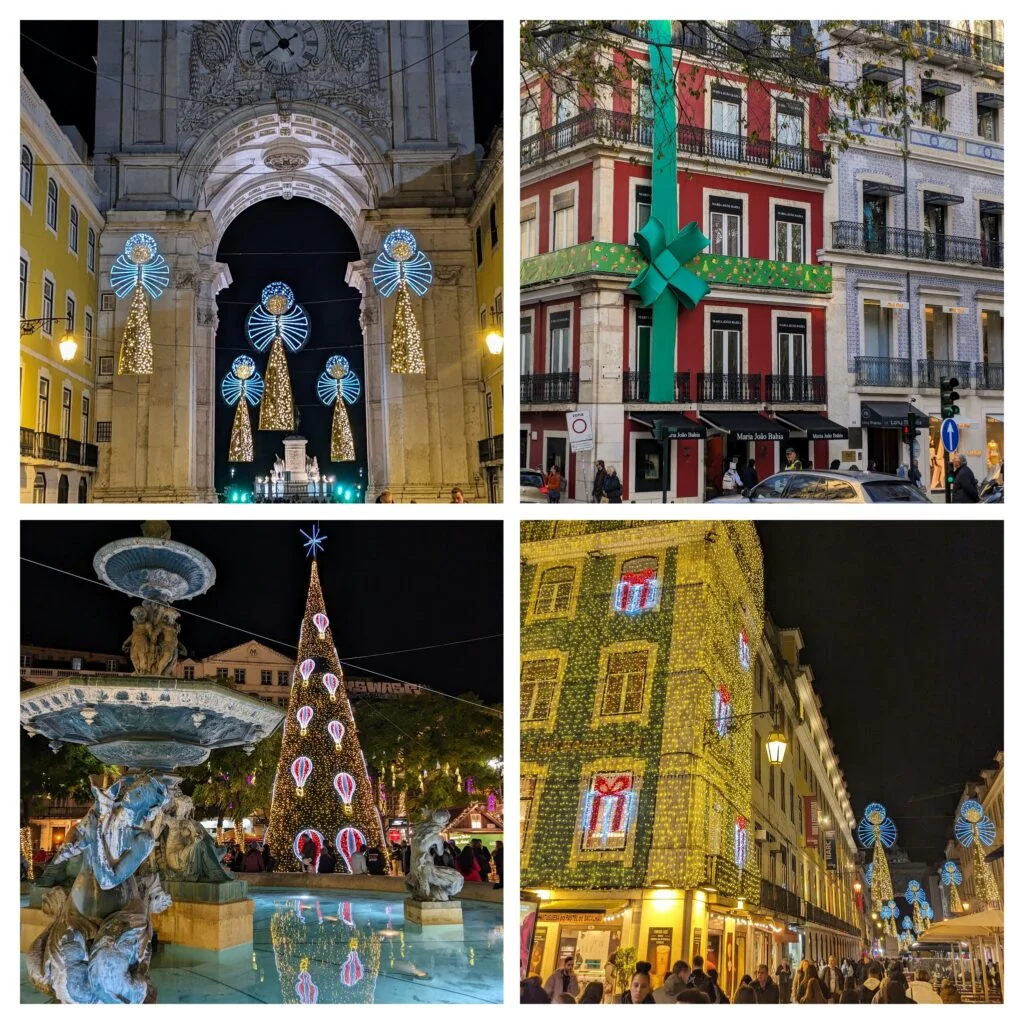
VISITING LISBON IN WINTER IS PROBABLY BETTER FOR THE LOCALS TOO
Before, during and after my trip to Lisbon, I came to understand the narrative that it has become a victim of its own success. This is a city of 3 million people, and A LOT of international tourists fly in each year for short stays, mostly between May and October. Summer is peak season across most of Europe though, and this is by no means unique to the Portuguese capital. However, many digital nomads now also call Lisbon home.
These recent immigrants, like its tourists, are attracted by low prices, great weather, and wonderful culture, lifestyle, and food. This is all very well for Dave from London, Hank from the US and Steffi from Germany who all earn above the newly introduced digital nomad visa limit of €3,280 per month. But, Portugal is one of Europe’s poorest countries and most locals earn far less than that. They’ve seen prices rising way beyond their means and they’re getting p@ssed off with property rentals also skyrocketing.
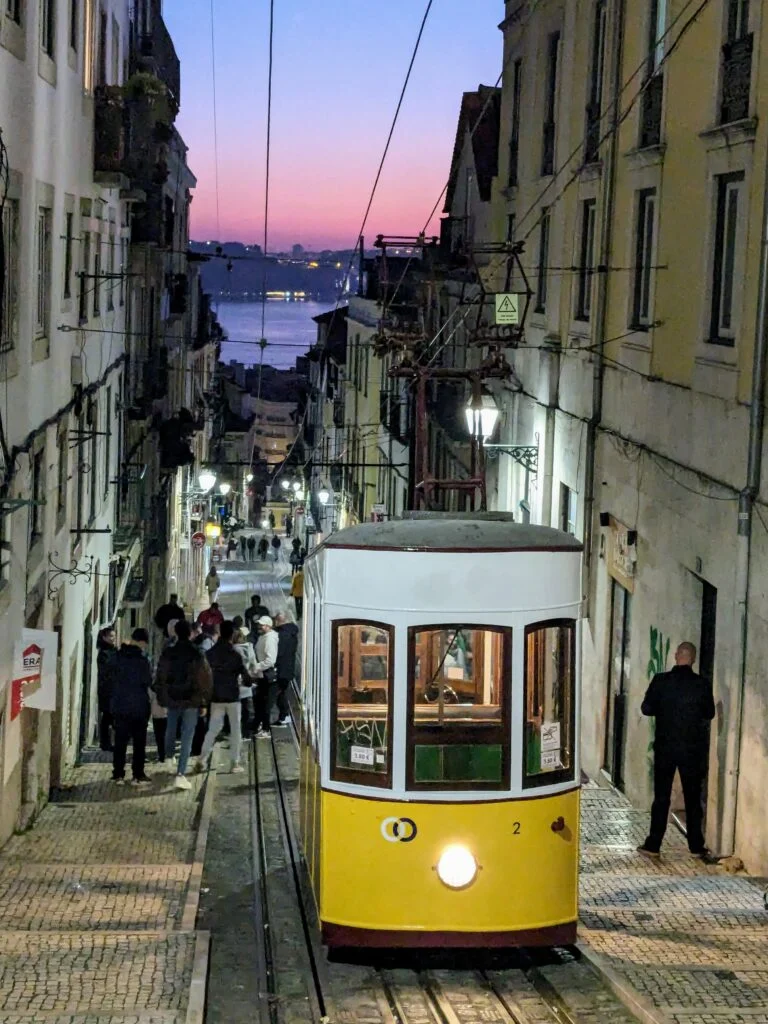
Considering its decent year-round weather & blue skies, there’s no reason not to visit Lisbon in winter or fall instead. Not only are there far less other tourists to contend with (the irony of this sentence is not lost on me, as I continue writing this guide to visiting Lisbon), but it takes the pressure off over-saturated municipal services and jaded locals, which arguably then gives you a more intimate, open and welcoming experience of its people and their culture. Anyway, that’s my theory and I’m sticking to it.
Getting Around on Public Transport
Lisbon’s public transport network is much less crowded between November and April. This means you have more space and are more likely to get a seat. Additionally, the local you’re probably traveling with is more likely to be accommodating of you and your massive suitcase.
Also, while Lisbon’s famous trams are literal classics, with that also comes the fact that most of these old timers don’t have air conditioning, so if you decide to hop on to give your legs a break from all the hills, then it’s going to be a much more comfortable journey when the temperatures aren’t hovering around the mid-30s!
My advice is to also make the most of the city’s cheap, clean, efficient and spacious metro network as much as you can.

THE BEST TIME TO VISIT LISBON: OUTRO
Lisbon is so cool and I know it’s great to visit in summer too, despite the heat, crowds and over-inflated prices. Lisbon in winter though, offers the same activities, restaurants and accommodation options but with far less competition for them. This means you spend less, while also getting a more personalised, patient and intimate experience with the local people.
You get to wander its districts and neighbourhoods in relative calm, and delve into its amazing food scene without having your Bacalhau Bras interrupted by someone asking to you to take a picture of them scoffing a Pastel de Nata. And you can’t put a price on that.

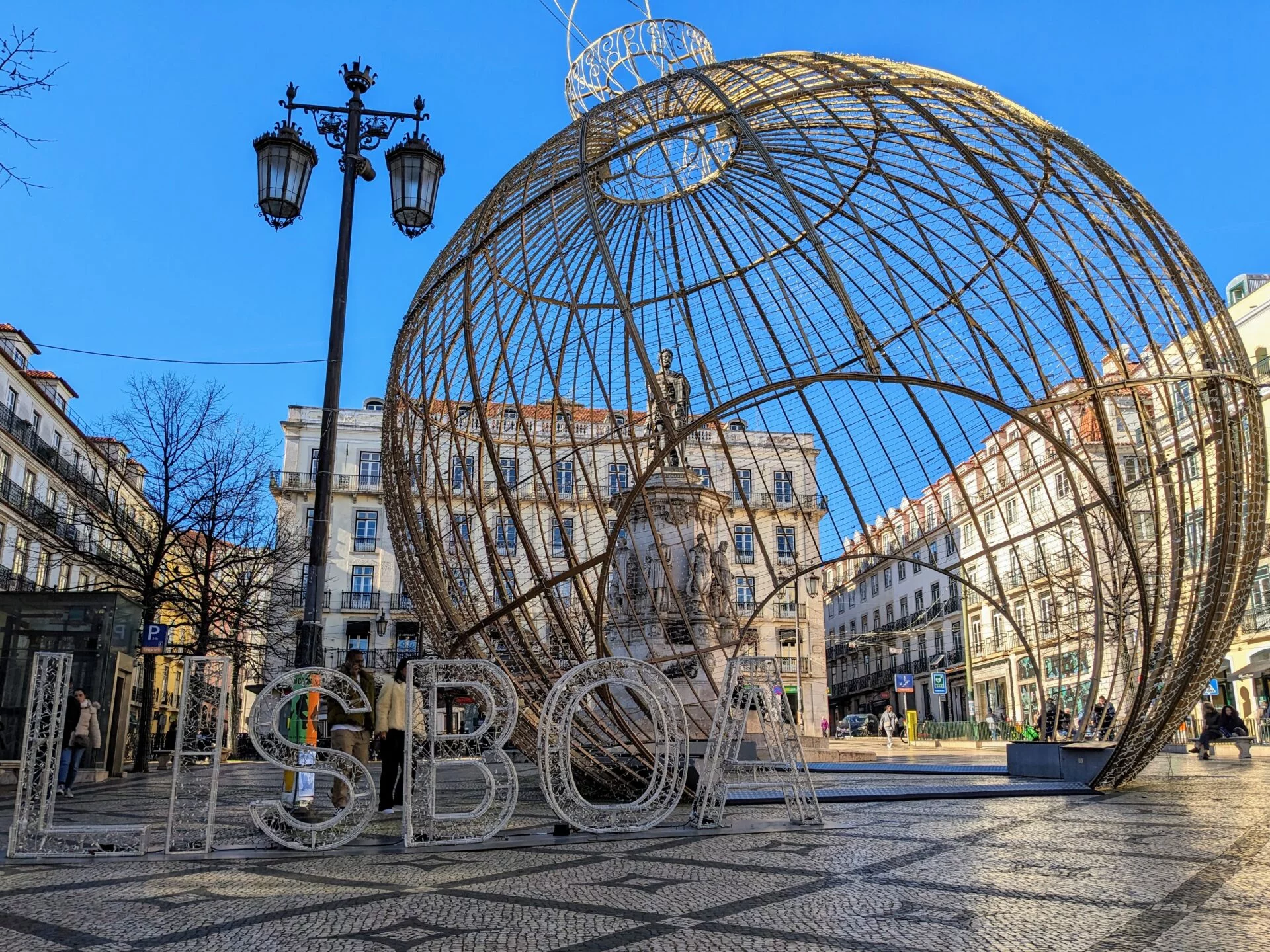



Lisbon in December sounds magical! I love the idea of exploring the city without the usual summer crowds. The lower accommodation prices and unique experiences, like private sunset cruises, really highlight the benefits of off-season travel. Plus, enjoying a Pastel de Nata while wandering through Alfama is the perfect winter escape!